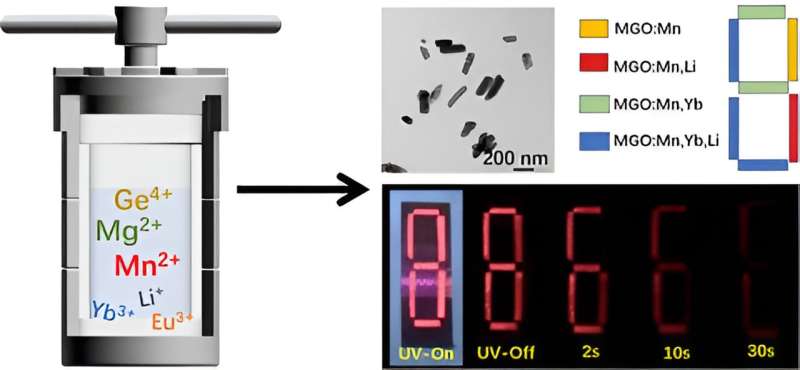This article has been reviewed according to Science X's editorial process and policies. Editors have highlighted the following attributes while ensuring the content's credibility:
fact-checked
trusted source
proofread
Researchers develop tuneable anti-counterfeiting material

Counterfeiters are becoming increasingly more sophisticated in forging everything from diplomas and currency to medications and artwork. While protective measures such as luminescent markings (which glow under ultraviolet light) have been around for a while, forgers have figured out how to exploit the weaknesses in these techniques.
Now a team of researchers from Western University has developed a promising new approach that offers multiple levels of anti-counterfeiting protection, making identifying markings much harder to forge. The technology they've developed uses materials with a property called persistent luminescence (PersL).
The study is published in the journal ACS Applied Nano Materials.
The luminescent materials currently in use for anti-counterfeiting become visible when exposed to UV light, but stop glowing when the light source is removed. The new materials created by the Western team—using the Canadian Light Source (CLS) at the University of Saskatchewan (USask)—are inorganic phosphor nanoparticles that remain visible to the human eye for several minutes after UV light is turned off.
They also give off a shade of red light that's not easily reproduced. Most significantly, an identification mark can be "programmed" to disappear in stages, with some elements vanishing almost immediately, while other elements fade away over several minutes.
The researchers achieved this tuneability by tinkering with the additives (dopants) they included in the base material, magnesium germanium oxide, to change its optical properties.
"We can incorporate these into our material to construct a complicated pattern so that different parts glow for different durations," says Dr. Lijia Liu, a professor in Western's Department of Chemistry. "That is our ultimate security. It will be very difficult to find something that can achieve that property."
While micrometer-sized persistent luminescent materials are already currently available, Liu and colleagues have developed a nanosized version, which can be used to print highly detailed patterns. The particles they created glow more brightly and longer than existing materials.
The team's work was informed by data collected at the CLS. Lead author Yihong Liu says the beamlines they used—Brockhouse, SGM, and IDEAS—enabled the team to better understand the interaction between the dopants and the base material, which is the key to the tunable afterglow.
"When you observe something unusual in the material made in the lab, you wonder why. The spectroscopy technologies at the Canadian Light Source are powerful tools to answer these questions," she says.
More information: Yihong Liu et al, Multiband MgGeO3-Based Persistent Luminescent Nanophosphors for Dynamic and Multimodal Anticounterfeiting, ACS Applied Nano Materials (2024). DOI: 10.1021/acsanm.4c01069
Provided by Canadian Light Source




















